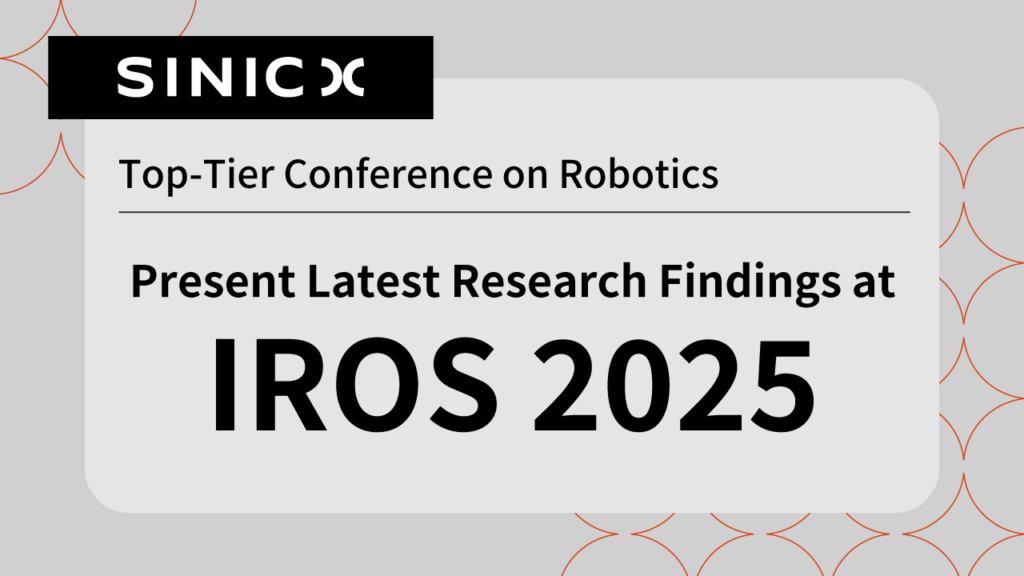
2025/05/09

OMRON SINIC X Corporation (HQ: Bunkyo-ku, Tokyo; President and CEO: Masaki Suwa; hereinafter “OSX”) will present the latest research findings at the 2025 IEEE/RSJ International Conference on Intelligent Robots and Systems (IROS 2025).
Along with ICRA1), IROS is one of the largest and most influential top-tier conferences in the field of robotics. In 2025, 1,991 papers (approximately 46.2%) were accepted out of 4,306 submissions, and the conference will be held in Hangzhou, China, from October 19 to 25 (local time).
1) IEEE International Conference on Robotics and Automation
The two research papers to be presented by OSX are as follows.
■ Pose Estimation of a Cable-Driven Serpentine Manipulator Utilizing Intrinsic Dynamics via Physical Reservoir Computing
Kazutoshi Tanaka (OSX), Tomoya Takahashi (OSX), Masashi Hamaya (OSX)
Cable-driven serpentine manipulators hold great potential in unstructured environments, offering obstacle avoidance, multi-directional force application, and a lightweight design. By placing all motors and sensors at the base and employing plastic links, we can further reduce the arm’s weight. To demonstrate this concept, we developed a 9-degree-of-freedom cable-driven serpentine manipulator with an arm length of 545 mm and a total mass of only 308 g. However, this design introduces flexibility-induced variations, such as cable slack, elongation, and link deformation. These variations result in discrepancies between analytical predictions and actual link positions, making pose estimation more challenging.
Cable-driven serpentine manipulators hold great potential in unstructured environments, offering obstacle avoidance, multi-directional force application, and a lightweight design. By placing all motors and sensors at the base and employing plastic links, we can further reduce the arm’s weight. To demonstrate this concept, we developed a 9-degree-of-freedom cable-driven serpentine manipulator with an arm length of 545 mm and a total mass of only 308 g. However, this design introduces flexibility-induced variations, such as cable slack, elongation, and link deformation. These variations result in discrepancies between analytical predictions and actual link positions, making pose estimation more challenging.
To address this challenge, we propose a physical reservoir computing based pose estimation method that exploits the manipulator’s intrinsic nonlinear dynamics as a high-dimensional reservoir.
Experimental results show a mean pose error of 4.3 mm using our method, compared to 4.4 mm with a baseline long short-term memory network and 39.5 mm with an analytical approach.
This work provides a new direction for control and perception strategies in lightweight cable-driven serpentine manipulators leveraging their intrinsic dynamics.
https://arxiv.org/pdf/2509.17308
https://omron-sinicx.github.io/prc-arm-pose/
■ WAVE: Worm Gear-based Adaptive Variable Elasticity for Decoupling Driving and External Forces
Moses Gladson Selvamuthu (OSX, Yamagata University), Tomoya Takahashi (OSX), Riichiro Tadakuma (Yamagata University), Kazutoshi Tanaka (OSX)
Robotic manipulators capable of regulating both compliance and stiffness offer enhanced operational safety and versatility. Here, we introduce Worm Gear-based Adaptive Variable Elasticity (WAVE), a variable stiffness actuator (VSA) that integrates a non-backdrivable worm gear.
By decoupling the driving motor from external forces using this gear, WAVE enables precise force transmission to the joint, while absorbing positional discrepancies through compliance. WAVE is protected from excessive loads by converting impact forces into elastic energy stored in a spring. In addition, the actuator achieves continuous joint stiffness modulation by changing the spring’s precompression length.
We demonstrate these capabilities, experimentally validate the proposed stiffness model, show that motor loads approach zero at rest —even under external loading —and present applications using a manipulator with WAVE.
This outcome showcases the successful decoupling of external forces. The protective attributes of this actuator allow for extended operation in contact-intensive tasks, and for robust robotic applications in challenging environments.
Robotic manipulators capable of regulating both compliance and stiffness offer enhanced operational safety and versatility. Here, we introduce Worm Gear-based Adaptive Variable Elasticity (WAVE), a variable stiffness actuator (VSA) that integrates a non-backdrivable worm gear.
By decoupling the driving motor from external forces using this gear, WAVE enables precise force transmission to the joint, while absorbing positional discrepancies through compliance. WAVE is protected from excessive loads by converting impact forces into elastic energy stored in a spring. In addition, the actuator achieves continuous joint stiffness modulation by changing the spring’s precompression length.
We demonstrate these capabilities, experimentally validate the proposed stiffness model, show that motor loads approach zero at rest —even under external loading —and present applications using a manipulator with WAVE.
This outcome showcases the successful decoupling of external forces. The protective attributes of this actuator allow for extended operation in contact-intensive tasks, and for robust robotic applications in challenging environments.
http://arxiv.org/abs/2509.21878
https://omron-sinicx.github.io/wave
※Author information is current as of the date of writing or submission. Please be advised that the information may become outdated after that point.
For any inquiries about OSX, please contact us here.